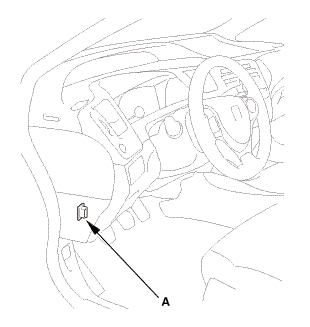Honda Civic Service Manual: Engine Oil Pan Removal and Installation (K24Z7)
1111Q1

| 1. | Warm Up The Engine |
|
| 2. | Upper Torque Rod Mounting Bolt - Loosen |
|
|
|
| 3. | Vehicle Lift |
|
| 4. | Engine Oil - Replacement |
|
|
|
| 5. | Front Wheel |
|
|
|
| 6. | Steering Joint Cover |
|
|
|
| 7. | Steering Column Lower Slide Shaft - Hold |
|
|
|
| 8. | Steering Joint Bolt - Loosen |
|
|
|
| 9. | Steering Wheel Hold |
|
|
|
| 10. | Steering Joint - Disconnection |
|
|
|
||||||||||||||||||||
| 11. | Splash Shield |
|
1. |
Remove the splash shield (A). |

| 12. | Front Stabilizer Ball Joint - Disconnection, Both Lower Arm Side |
|
|
|
| 13. | Lower Arm Joint - Disconnection, Both Knuckle Side |
|
|
|
| 14. | Engine Support Hanger |
|
|
|
|
|
|
||||||||||||
| 15. | Lower Torque Rod - Disconnection |
|
|
|
| 16. | Front Sub Frame - Move |
|
|
|
|
FRONT
REAR
|
|
| 17. | Lower Torque Rod Bracket |
|
|
|
| 18. | Clutch Cover |
|
|
|
| 19. | Oil Pan Assembly |
|
|
|
|
|
|

| 1. | Oil Pan Assembly |
|
|
|
||||||||||||||||||||||||||
|
|
|
|||||||||||||||||
| 2. | Clutch Cover |
|
|
|
| 3. | Lower Torque Rod Bracket |
|
|
|
| 4. | Front Sub Frame - Move |
|
REAR
FRONT
|
|
| 5. | Front Subframe Assembly |
|
1. |
Loosely install the new front subframe mounting bolts (A). |
 n-m77lm41!
n-m77lm41!
|
2. |
Insert the subframe alignment pin (B) through the positioning hole (C) on the right front subframe, and into the positioning hole (D) on the body, then loosely tighten the subframe right front mounting bolt. |
|
3. |
Insert the subframe alignment pin through the positioning slot on the left front subframe, and into the positioning hole on the body, then loosely tighten the subframe left front mounting bolt. |
|
4. |
Tighten the subframe mounting bolts to the specified torque values starting with the right front subframe mounting bolt. Use the subframe alignment pin when tightening the front side subframe mounting bolts. |
|
5. |
Check all of the subframe mounting bolts, and retighten if necessary. |
|
|
NOTE: Tighten the bolts in the sequence shown. |
||
| 6. | Lower Torque Rod - Reconnection |
|
|
|
| 7. | Engine Support Hanger |
|
|
|
| 8. | Lower Torque Rod Mounting Bolt - Tighten |
|
|
|
| 9. | Lower Arm Joint - Reconnection, Both Knuckle Side |
|
|
|
| 10. | Front Stabilizer Ball Joint - Reconnection, Both Lower Arm Side |
|
|
|
| 11. | Upper Torque Rod - Tighten |
|
|
|
| 12. | Steering Column Lower Slide Shaft - Release |
|
|
|
| 13. | Steering Wheel Release |
|
|
|
| 14. | Steering Joint - Reconnection |
|
|
|
||||||||||||||||||||
|
|
|
| 15. | Steering Joint Bolt - Tighten |
|
|
|
| 16. | Steering Joint Cover |
|
|
|
| 17. | Front Wheel |
|
|
|
||||||
| 18. | Engine Oil - Replacement |
|
|
|
|||||||||||||||||||||||||||||
| 19. | Splash Shield |
|
1. |
Install the splash shield (A). |

| 20. | Pre-Alignment Checks |
|
| 21. | Caster - Inspection |
|
|||||||||||||||||||||||||||||||||||||||||||||||
| 22. | Camber - Inspection |
|
||||||||||||||||||||||||||||||||||||||||||||||||||||||||||||||||||||||||||||||||||||||
| 23. | Front Toe - Inspection |
|
|||||||||||||||||||||||||
| 24. | Turning Angle - Inspection |
|
|
|
|||||||||||||||||||||||||||||||||||||||||||||||||||||||||||||||||||||||||||||||||||||||||
|
|
|
|||||||||||||||||||||||||||||||||||||||||||||||||||||||||
| 25. | HDS DLC - Connection |
|
|
|
| 26. | VSA Sensor Neutral Position - Memorization |
|
||||||||||
| 27. | Steering Angle Sensor Neutral Position - Clear |
|
|||||||
| 28. | Maintenance Minder Reset |
|
 Engine Oil Jet and Bolt Inspection (R18Z1)
Engine Oil Jet and Bolt Inspection (R18Z1)
Removal
1.
Intake Manifold and Throttle Body Assembly
1.
Remove the intake air duct.
...
 Engine Oil Replacement
Engine Oil Replacement
1.
Warm Up The Engine
1.
Warm up the engine.
2.
Vehicle Lift
...
See also:
Honda Civic Owners Manual. Automatic Intermittent Wipers
When you push the lever down to AUTO, the
windshield wipers sweep once, and go into
the automatic mode.
The wipers operate intermittently, at low
speed, or at high speed and stops in
accordance with the amount of rainfall the
rainfall sensor detects.
AUTO sensitivity adjustment
When th ...












 o7aaksnaai2o
o7aaksnaai2o
















 mm
mm 27m.27
27m.27 i2mm
i2mm



 mm:.o21
mm:.o21
 mmmln-mnomm
mmmln-mnomm

